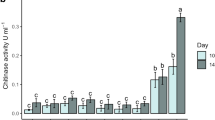Abstract
Three species of botryosphaeriaceous fungi,Botryosphaeria sp. isolate MAMB-5,Botryosphaeria ribis andLasiodiplodia theobromae, were compared for the production of pycnidia and laccases. Laccases were produced both intra- and extra-cellularly when the fungi were cultivated on basal medium in the presence and absence of veratryl alcohol, withBotryosphaeria sp. MAMB-5 showing the highest enzyme titres. Electrophoretic examination of intracellular marker proteins (esterases and phosphatases) and laccases indicated that the three species were genetically distinctly different, although the laccase zymograms for the three fungi showed similarity. The production of pycnidia occurred under continuous lighting at 28°C, but conditions differed among the three fungal species. Production could be induced on artificial media (potato-dextrose and oat agar) under stress-induced conditions where the mycelium was stimulated by physical abrasion, and in the case ofBotryosphaeria sp. isolate MAMB-5 on eucalypt woodchips. Evidence is presented that veratryl alcohol facillitated the secretion of intracellular-localised laccases into the extracellular medium.
Similar content being viewed by others
Literature cited
Aderiye, B. I., Laleye, S. A. and Ojo, B. 1988. Toxicity of citric and succinic acids for the pycnidiospores ofBotryodiplodia theobromae. Folia Microbiol.43: 147–150.
Barbosa, A. M., Dekker, R. F. H., Kurtböke, I. and Hardy, G. E. 1995.In-vivo decolorisation of Poly R-478 as a method for screening ligninolytic microorganisms for use in bioremediation. 4th Pacific Rim Biotechnol. Conf., Melbourne, Australia, Feb 6–9, pp. 88–90.
Barbosa, A. M., Dekker, R. F. H., and Hardy, G. E. 1996. Veratryl alcohol as an inducer of laccase by an ascomycete,Botryosphaeria sp., when screened on the polymeric dye Poly R-478. Lett. Appl. Microbiol.23: 93–96.
Biggs, A. R. 1995. Detection of latent infections in apple fruit with paraquat. Plant Disease79: 1062–1067.
Brune, W., Alfenas, A. C. and Junghans, T. G. 1998. Identificações específicas de enzimas em géis. In: Electrophoesis de isoenzimas e protéinas afins. Fundamentos e aplicações em plantas e microrganismos, (ed. by Alfenas, AC.), pp. 201–328. Editore Universidade Federal de Viçosa, Viçosa, MG, Brazil. (In Portuguese.)
Dekker, R. F. H. and Barbosa, A. M. 2001. The effect of aeration and veratryl alcohol on the production of 2 laccases by the ascomycete,Botryosphaeria sp. Enzyme Microb. Technol.28: 81–88
Eggert, C., Temp, U. and Eriksson, K. E. L. 1996a. Laccase-producing white-rot fungus lacking lignin peroxidase and manganese peroxidase: role of laccase in lignin biodegradation. In: Enzymes for Pulp and Paper Processing, ACS Symposium Series655, (ed. by Jeffries, T. W. and Viikari, L.), pp. 130–150. American Chemical Society, Washington, DC.
Eggert C., Temp, U. and Eriksson, K. E. 1996b. The ligninolytic system of the white rot fungusPycnoporus cinnabarinus: purification and characterisation of the laccase. App. Environ. Microbiol.62: 1151–1158.
Gianfreda, L., Xu, F. and Bollag, J-M. 1999. Laccases: a useful group of oxidoreductive enzymes. Bioremediation J.3: 1–25.
Gupta, V. P., Tewari, S. K., Govindaiah, and Bajpai, A. K. 1999. Ultrastructure of mycoparasitism ofTrichoderma, Gliocladium andLaetisaria species onBotryodiplodia theobromae. J. Phytopathol.147: 19–24.
Hanlin, R. T. and Menezes, M. 1996. Generos ilustrados de ascomicetos. Imprensa da Universidade Federal Rural de Pernambucco, Recife, PE, Brazil. (In Portuguese.)
Jacobs, K. A. and Rehner, S. A. 1998. Comparison of cultural and morphological characters and ITS sequences in anamorphs ofBotryosphaeria and related taxa. Mycologia90: 601–610.
Johannes, C. and Majcherczyk, A. 2000. Natural mediators in the oxidation of polycyclic aromatic hydrocarbons by laccase mediator systems. Appl. Environ. Microbiol.66: 524–528.
Kües, U. and Liu, Y. 2000. Fruiting body production in basidiomyces. Appl. Microbiol. Biotechnol.54: 141–152.
Laemmli, V. K. 1970. Cleavage of structural proteins during the assembly of the head of bacteriophage T4. Nature227: 681–685.
Messerschmidt, A. 1997. Multi-Copper Oxidases. World Scientific, Singapore.
O'Malley, D. M., Whetten, R., Bao, W., Chen, C-L. and Sederoff, R. 1993. The role of laccase in lignification. Plant J.4: 751–757.
Palmieri, G., Giardina, P., Bianco, C., Fontanella, B. and Sannia, G. 2000. Copper induction of laccase isoenzymes in the ligninolytic fungusPleurotus ostreatus. Appl. Environ. Microbiol.66, 920–924.
Pointing, S. B., Jones, E. B. G. and Vrijmoed, L. L. P. 2000. Optimization of laccase production byPycnoporus sanguineus in submerged liquid culture. Mycologia92: 139–144.
Ramos, L. J., Davenport, T. L., McMillan, R. T. and Lara, S. P. 1997. The resistance of mango (Mangifera indica) cultivars to tip dieback disease in Florida. Plant Disease81: 509–514.
Rayachhetry, M. B., Elliott, M. L., Center, T. D. and Laroche, F. 1999. Field evaluation of a native fungus for control of melaleuca (Melaleuca quinquenervia) in southern Florida. Weed Technol.13: 59–64.
Shaw, C. R. and Prasad, R. 1970. Starch electrophoresis of enzymes—a complication of recipes. Biochem. Genet.4: 297–320.
Silveira, R. L. V., Krugner, T. L., Silveira, R. I. and Goncalves, A. N. 1996. Effect of boron on the susceptibility ofEucalyptus citriodora toBotryosphaeria ribis andLasiodiplodia theobromae. Fitopathol. Bras.21: 482–485.
Srebotnik, E. and Hammel, K. E. 2000. Degradation of nonphenolic lignin by the laccase/1-hydroxybenzotriaole system. J. Biotechnol.81: 179–188.
Vasconcelos, A.-F. D., Barbosa, A. M., Dekker, R. F. H., Scarcaminio, I. S. and Rezende, M. I. 2000. Optimization of laccase production byBotryosphaeria sp. in the presence of veratryl alcohol by the response-surface method. Process Biochem.35: 1131–1138.
Vogel, H. J. 1956. A convenient growth medium forNeurospora crassa. Genetic Bull.13: 42–43.
Williamson, P. R. 1997. Laccase and melanin in the pathogenesis ofCryptococcus neoformans. Frontiers in Science2: 99–107.
Yuan, Z. Q. and Mohammed, C. 1999. Pathogenicity of fungi associated with stem cankers of eucalypts in Tasmania, Australia. Plant Disease83: 1063–1069.
Author information
Authors and Affiliations
About this article
Cite this article
Vasconcelos, AF.D., Dekker, R.F.H., Barbosa, A.M. et al. Comparison of the laccases, molecular marker proteins, and induction of pycnidia by three species of botryosphaeriaceous fungi. Mycoscience 42, 543–548 (2001). https://doi.org/10.1007/BF02460952
Received:
Accepted:
Issue Date:
DOI: https://doi.org/10.1007/BF02460952




